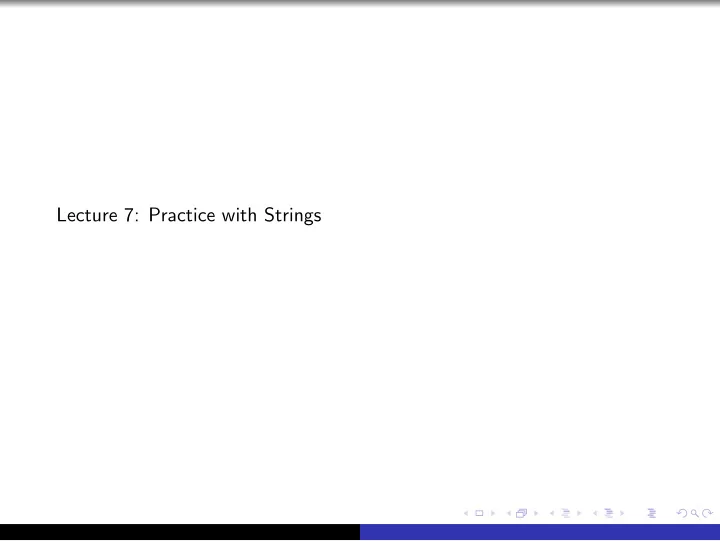

Lecture 7: Practice with Strings
Predicting operations on s What does s equal after the following operations? >>> s = "the rain in spain stays mainly on the plain" >>> s[3] >>> s[:3] >>> s[4:] >>> s[4:8] >>> s[7:3:-1] >>> s[::-1]
Predicting operations on s >>> s = "the rain in spain stays mainly on the plain" >>> s[3] ’ ’ >>> s[:3] ’the’ >>> s[4:] ’rain in spain stays mainly on the plain’ >>> s[4:8] ’rain’ >>> s[7:3:-1] ’niar’ >>> s[::-1] ’nialp eht no ylniam syats niaps ni niar eht’
Practice with String Methods split and join Write a function totab that given a comma delimited string like "name,yob,age,weight" returns a tab delimited string like "name\tyob\tage\tweight" . upper and lower Write a function called capitalize that given a string returns the same string but with the first character capitalized and the remaining characters in lowercase. For example, capitalize(’pURPle’) returns ’Purple’ find Write a function called begins that given a string s and a prefix pre returns True if and only if s begins with pre . find and len Write a function called ends that given a string s and a suffix suf returns True if and only if s ends with suf
capitalize def capitalize(s): ”””return a capitalized version of s””” return (s[0].upper + s[1:].lower())
totab def totab(s): ”””replace the commas in s with tabs””” return ” \ t”.join(s.split(”,”))
begins def begins(s, pre): ”””returns True if and only if s begins with pre””” return s.find(pre) == 0
ends def ends(s, suf): ”””returns True if and only if s ends with suf””” loc = len (s) − len (suf) return s.find(suf, loc) == loc
double and substring ⋆ A string is called a double string when it is composed of two words repeated twice. Examples of double strings include pizzapizza and heyhey . Write a function called double(s) that return True if and only if s is a double string. ⋆ Given a string t of length n , a subsequence s of length m ≤ n of t is a string that appears in t when characters of t may be dropped. For example ada is a subsequence of madman because dropping both m s and the n from madman yields ada . Write a function called subsequence(s,sub) that returns True if and only if sub is a subsequence of s .
double and substring def double(s,): ”””returns True if and only if s is a double string””” n = len (s) return (n % 2 == 0) and (s[0:n//2] == s[n//2:n]) def subsequence(s,sub): ’’’returns True if and only if sub is a subsequence of s’’’ start = 0 for c in sub: index = s.find(c, start) if index == − 1: return False start = index + 1 return True
Recommend
More recommend